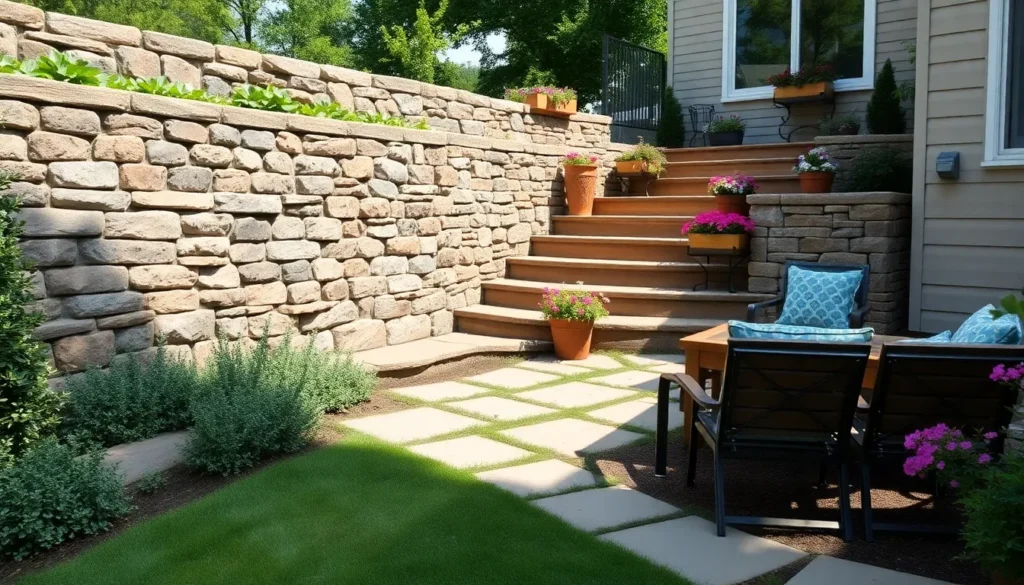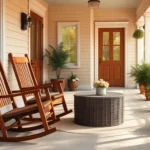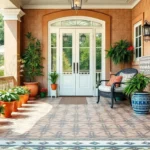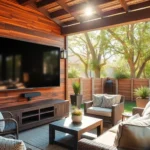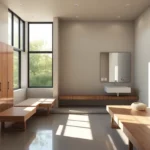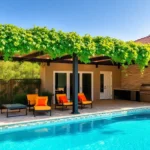Transform your outdoor space with stunning patio retaining walls that combine function and beauty. We’ve discovered that the right retaining wall doesn’t just prevent soil erosion – it creates the perfect foundation for an extraordinary patio experience.
Whether you’re dealing with a sloped yard or simply want to add dimension to your outdoor living area, patio retaining walls offer endless possibilities. From natural stone masterpieces to modern concrete designs, we’ll show you how these structures can become the centerpiece of your backyard oasis.
Ready to turn that challenging slope into your favorite outdoor retreat? We’ve compiled the most creative and practical patio retaining wall ideas that’ll have your neighbors asking for your secret. These aren’t just walls – they’re opportunities to create built-in seating, planters, and multi-level entertainment spaces that maximize every square foot of your property.
Natural Stone Retaining Walls for Elegant Patio Design
Natural stone materials elevate any patio design with their timeless beauty and structural integrity. Stone walls create sophisticated focal points that seamlessly blend with surrounding landscapes while providing essential soil support for elevated outdoor spaces.
Fieldstone Walls for Rustic Charm
Fieldstone retaining walls bring authentic countryside elegance to modern patio designs. These naturally weathered stones feature irregular shapes and varied colors that create organic, flowing lines throughout your outdoor space. We recommend using local fieldstone varieties like Pennsylvania bluestone or New England granite for walls that complement regional architecture.
Building fieldstone walls requires dry stacking techniques that allow for natural drainage and seasonal ground movement. Stack stones without mortar to create gaps that encourage proper water flow and prevent hydrostatic pressure buildup. Each stone should overlap the joints below by at least 6 inches for maximum stability.
Maintenance for fieldstone walls involves occasional repositioning of loose stones and clearing vegetation from joints. Plants like creeping thyme or moss can enhance the rustic appearance when allowed to grow between stone gaps. These living accents soften hard edges while maintaining the wall’s structural performance.
Limestone Blocks for Contemporary Appeal
Limestone blocks offer clean geometric lines that complement modern patio aesthetics perfectly. These uniform stones provide consistent color tones ranging from warm cream to cool gray that work beautifully with contemporary outdoor furniture and architectural elements. We find limestone particularly effective for creating terraced patio levels and integrated seating areas.
Cutting limestone blocks allows for precise fitting and professional installation results. Standard block sizes of 12x6x4 inches or 18x8x6 inches provide excellent structural stability while maintaining visual proportions. Mortar joints between blocks should measure 3/8 inch for optimal weather resistance and clean appearance.
Sealing limestone surfaces protects against staining and weather damage in harsh climates. Apply penetrating sealers every 2-3 years to maintain the stone’s natural beauty and prevent moisture absorption. Power washing with mild soap removes surface dirt without damaging the limestone’s porous texture.
Granite Slabs for Modern Sophistication
Granite slabs deliver unmatched durability and refined elegance for upscale patio retaining walls. These dense igneous stones resist weathering, cracking, and fading while maintaining their polished appearance for decades. We select granite colors like charcoal black, steel gray, or warm beige to create stunning visual contrasts with surrounding plantings.
Installing granite slabs requires professional expertise due to their substantial weight and precision requirements. Each slab typically measures 4-6 feet in length and weighs 200-400 pounds depending on thickness. Proper foundation preparation includes 6-8 inches of compacted gravel base and steel reinforcement for walls exceeding 4 feet in height.
Finishing granite surfaces with various textures adds visual interest and practical benefits to patio walls. Flamed finishes provide slip resistance for seating areas while polished surfaces reflect light and create elegant nighttime ambiance. Bush hammered textures offer subtle grip patterns that enhance safety around pool areas and water features.
Concrete Block Retaining Walls for Budget-Friendly Solutions
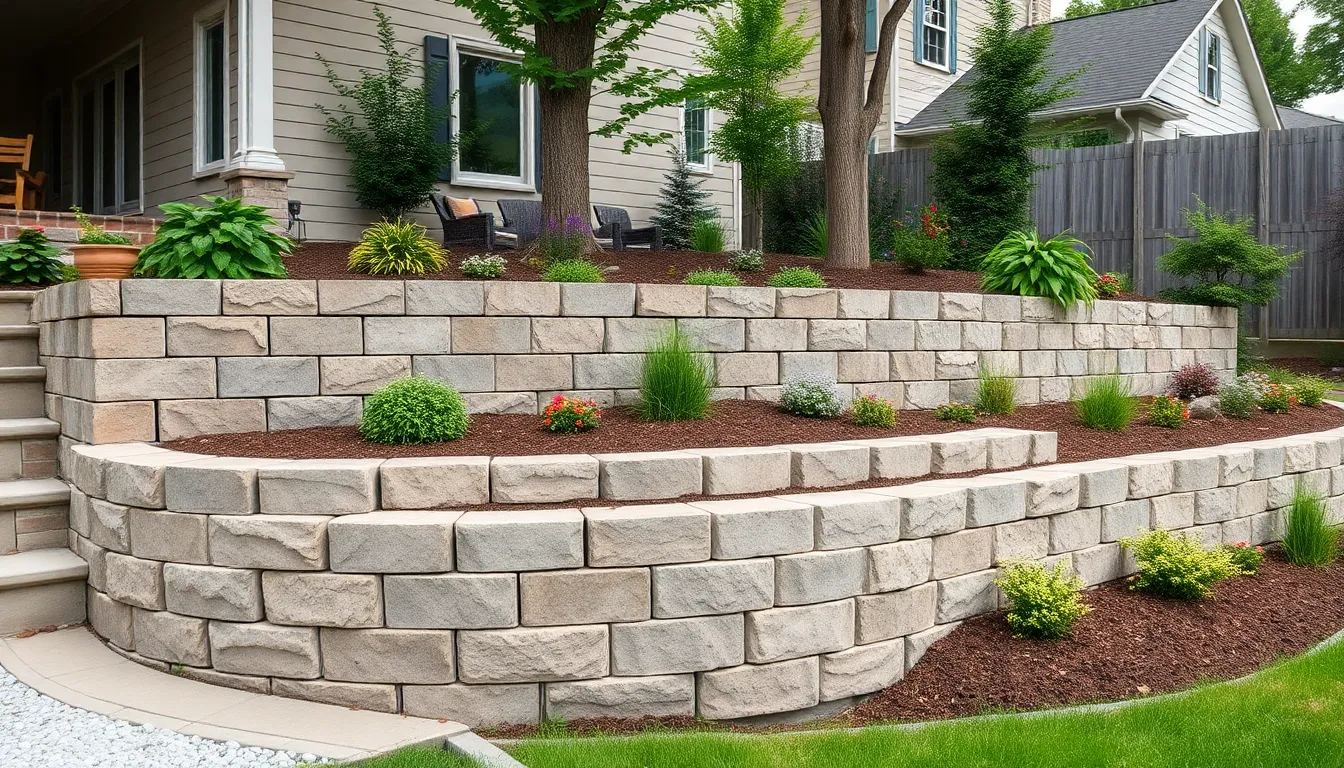
Concrete blocks offer an affordable and durable material choice that won’t strain your project budget. Their wide availability and low cost make them ideal for creating functional patio space while effectively retaining soil in your backyard setting.
Interlocking Concrete Blocks for Easy Installation
Interlocking concrete blocks eliminate the need for mortar during installation, making them perfect for DIY enthusiasts. These blocks feature precision-engineered connections that allow them to fit together securely while reducing labor costs significantly.
Modular design capabilities enable you to create curved or stepped wall configurations that blend naturally with your industry. Systems like Allan Block provide aesthetic versatility through various colors and textures, making them popular choices for patio and stair applications.
Textured surfaces on these blocks add visual interest while maintaining structural integrity. We recommend using interlocking systems for projects where you want professional results without the complexity of traditional masonry work.
Decorative Concrete Blocks with Textured Finishes
Decorative concrete blocks transform functional retaining walls into attractive industry features through their textured finishes. Ribbed, fluted, and embossed surfaces mimic natural stone and other premium materials while maintaining affordability.
Visual interest increases when you combine these blocks with planting beds, water features, or built-in seating elements. Homeowners can complement existing landscaping themes while ensuring the wall maintains its structural purpose.
Multiple finish options allow you to match your patio’s overall design aesthetic. We often see these blocks used in multi-tiered designs that reduce structural load while creating attractive planting areas between wall levels.
Split-Face Concrete Blocks for Natural Appearance
Split-face concrete blocks deliver a rough, rugged surface that closely resembles natural stone through mechanical splitting processes. This manufacturing technique exposes textured faces that create authentic-looking finishes at a fraction of natural stone costs.
Rustic charm emerges when these blocks blend organically with outdoor environments while providing reliable structural performance. Single or multi-tiered wall configurations work equally well with split-face blocks, offering both stability and natural visual appeal.
Outdoor living spaces benefit from the organic appearance these blocks provide without the premium pricing of natural materials. We recommend split-face options when you want the look of natural stone retaining walls while staying within a concrete block budget.
Timber Retaining Walls for Warm Outdoor Spaces
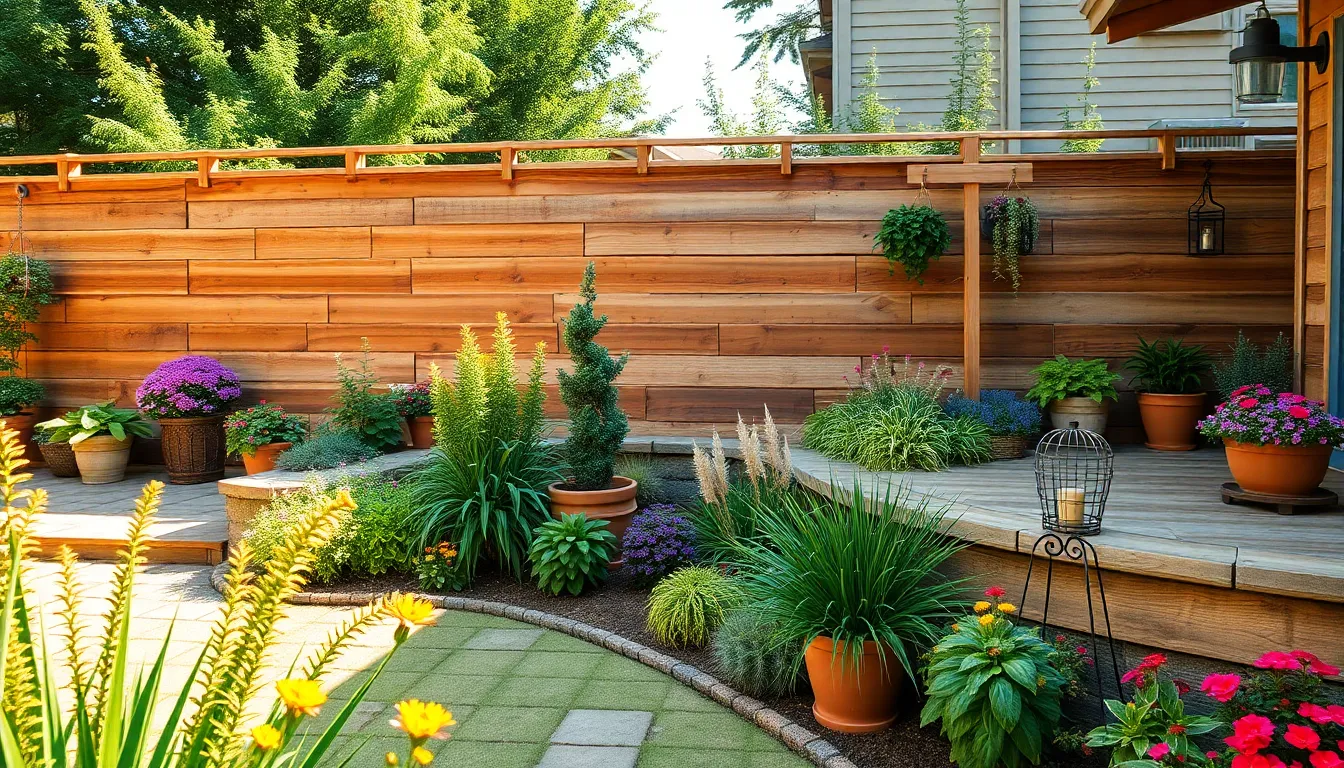
Timber brings natural warmth and character to patio retaining walls that concrete and stone simply can’t match. We’ll explore three timber options that offer distinct advantages for creating inviting outdoor spaces.
Pressure-Treated Lumber for Durability
Pressure-treated lumber delivers exceptional longevity through chemical treatments that resist rot, decay, and insect damage. These treatments make the wood highly durable for outdoor applications where soil contact is inevitable.
Cost-effectiveness makes pressure-treated lumber our top recommendation for structural retaining walls supporting soil on patios or garden beds. The material withstands harsh weather conditions while maintaining its structural integrity over many years.
Proper sealing and maintenance extend the lifespan of pressure-treated walls significantly. Regular applications of wood sealant preserve the rustic wood appearance while protecting against moisture penetration and UV damage.
Cedar Planks for Natural Weather Resistance
Cedar contains natural oils that resist moisture, decay, and insect infestation without requiring chemical treatments. This natural resistance makes cedar an environmentally friendly choice for eco-conscious homeowners.
Rich color and fine grain texture characterize cedar planks, adding warmth that ages beautifully over time. The wood develops an attractive silver-gray patina when left untreated, or maintains its original hue with proper staining.
Blending seamlessly with plantings or stone features, cedar creates an upscale, natural look in patios and landscaped areas. The material complements both modern and traditional design styles while providing excellent structural support.
Railroad Ties for Industrial Style
Railroad ties provide bold, industrial aesthetics with their large timber blocks and distinctively weathered surfaces. Reclaimed ties offer authentic character that new lumber simply cannot replicate.
Extreme strength allows railroad ties to be stacked into sturdy retaining walls, steps, or terracing systems on patios. Their substantial size and weight create impressive structural stability for challenging terrain.
Rugged character appeals to homeowners seeking rustic or industrial-themed outdoor spaces. But, proper sealing or treatment ensures longevity and safety, as some older ties may contain preservatives requiring careful handling.
Brick Retaining Walls for Classic Patio Aesthetics
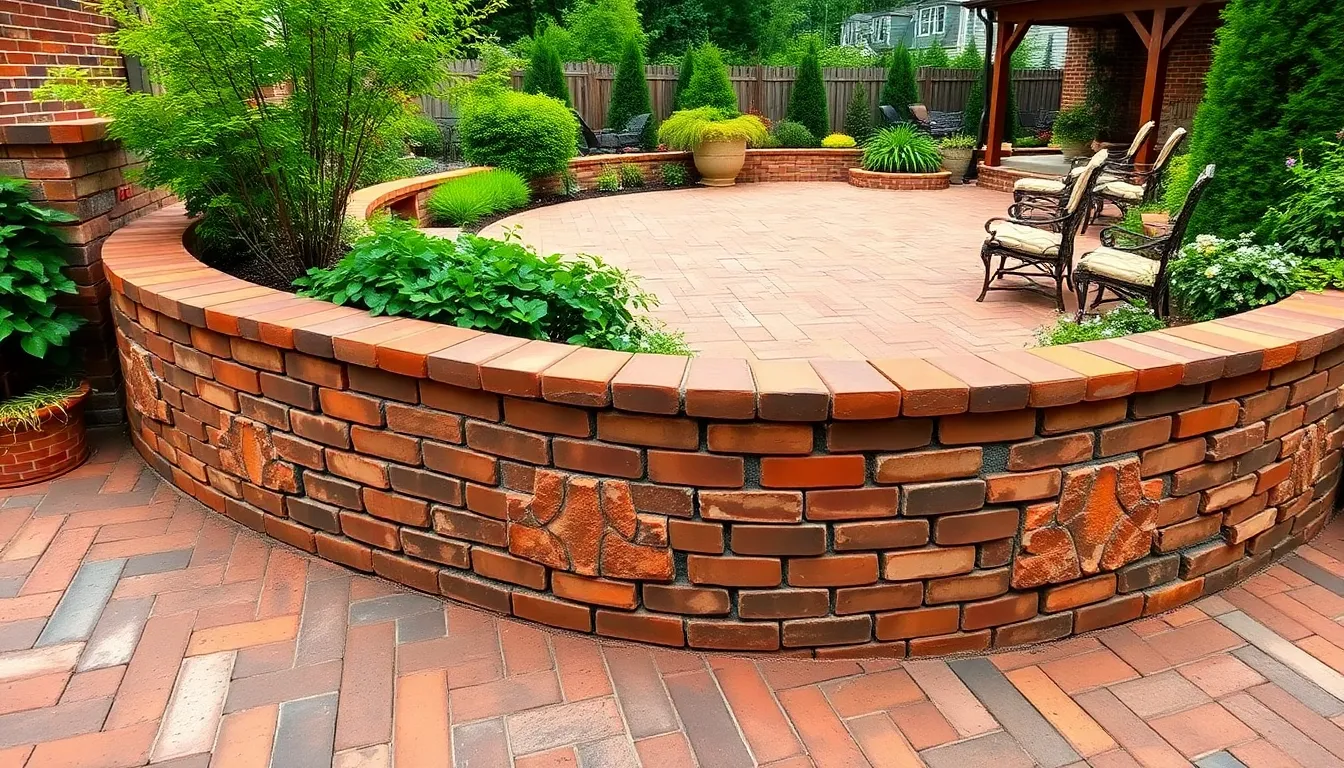
Brick retaining walls represent the pinnacle of traditional outdoor design, offering both structural integrity and timeless visual appeal. We’ll explore three distinctive brick approaches that transform ordinary patios into sophisticated outdoor retreats.
Traditional Red Brick for Timeless Appeal
Traditional red brick creates an instantly recognizable classic aesthetic that never goes out of style. We appreciate how these warm-toned bricks complement green landscaping and natural stone elements commonly found in outdoor spaces. The familiar texture and rich color palette of red brick evokes durability and tradition, making it perfect for patios seeking elegant sophistication.
Building with traditional red brick offers exceptional versatility in design applications. We recommend incorporating these bricks in straight-lined patterns for formal settings or curved configurations for softer, more organic appearances. The natural color variations within red brick create subtle depth while maintaining visual consistency throughout your patio space.
Maintenance becomes straightforward with traditional red brick since these materials age gracefully over time. We find that weathering actually enhances the character of red brick walls, developing beautiful patina that adds to their classic charm.
Reclaimed Brick for Vintage Character
Reclaimed brick brings authentic vintage character through materials with genuine history and weathered charm. We love how these previously used bricks display unique patina, weathering patterns, and color variations that can’t be replicated in new materials. Each reclaimed brick tells a story through its worn edges and distinctive markings from decades of use.
Environmental benefits make reclaimed brick an eco-friendly choice for sustainable patio design. We emphasize how choosing reclaimed materials reduces waste while contributing to cottage garden and old-industry design aesthetics. The irregular surface textures and varied coloration of reclaimed bricks create visual interest that perfectly complements rustic outdoor settings.
Installation with reclaimed brick requires careful selection since not all pieces will be structurally sound. We recommend thoroughly inspecting each brick for cracks or excessive wear before incorporating them into your retaining wall design.
Multi-Color Brick Patterns for Visual Interest
Multi-color brick patterns transform functional retaining walls into artistic focal points through strategic color combinations. We create stunning visual depth by mixing different brick shades including reds, browns, grays, and tans within single wall structures. Herringbone patterns showcase these color variations beautifully while maintaining structural integrity.
Basketweave arrangements offer another sophisticated approach to multi-color brick design. We achieve maximum visual impact by alternating brick orientations while incorporating complementary color schemes that enhance rather than overwhelm the patio space. These patterns add texture and dimension without requiring complex installation techniques.
Design flexibility allows us to customize multi-color brick patterns based on existing patio elements. We recommend selecting color combinations that harmonize with outdoor furniture, landscaping, and architectural features to create cohesive outdoor environments that feel intentionally designed rather than randomly assembled.
Gabion Retaining Walls for Contemporary Landscape Design
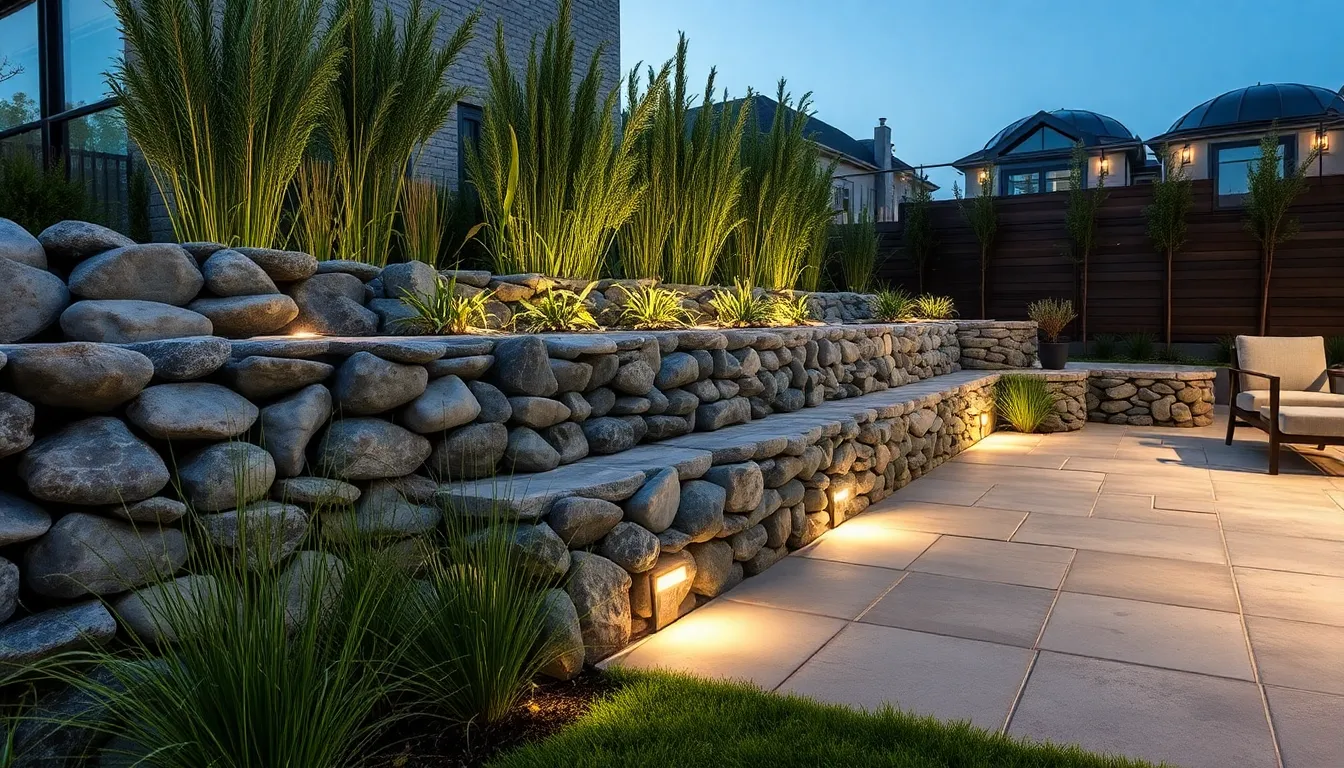
We can transform our patio spaces with gabion retaining walls that combine industrial elegance with natural materials. These wire mesh structures offer both functional support and striking visual appeal for modern outdoor environments.
Wire Mesh Baskets Filled with River Rock
River rock filling creates stunning texture variations that enhance the natural appearance of gabion walls. We appreciate how these stones’ different sizes and colors provide visual depth while maintaining excellent structural integrity. Their irregular shapes allow water to flow freely through the wall, creating an efficient drainage system that protects our patio foundations.
Natural river stones offer superior permeability compared to solid retaining wall materials. We find that this drainage capability prevents water buildup behind the wall, reducing hydrostatic pressure and extending the structure’s lifespan. The varied stone sizes create interesting shadow patterns throughout the day, adding ever-changing visual elements to our outdoor spaces.
Decorative Stone Fill Options
Crushed stone alternatives provide us with expanded design possibilities beyond traditional river rock. We can select colored gravel that complements our patio’s existing color palette, creating cohesive outdoor aesthetics. Polished pebbles offer smooth surfaces that reflect light beautifully, particularly when combined with modern concrete pavers or sleek outdoor furniture.
Mixed stone combinations allow us to create custom visual effects within each gabion basket. We often layer different stone types to achieve gradient effects or incorporate contrasting colors for bold design statements. These decorative fills work exceptionally well when paired with contemporary industry elements like ornamental grasses or architectural planters.
Integration with Modern Lighting Systems
LED strip lighting transforms gabion walls into dramatic evening focal points that extend our patio’s usable hours. We can install these lights along the wall’s top edge or embed them within the wire mesh structure for subtle illumination effects. The light filtering through the stone gaps creates captivating shadow patterns on surrounding surfaces.
Recessed lighting systems enhance both safety and ambiance around our retaining wall areas. We position these fixtures strategically to highlight the stone textures while providing adequate pathway illumination. The interplay between light and the wire mesh framework creates sophisticated visual interest that elevates our entire outdoor environment.
Modern lighting integration allows us to showcase the wall’s industrial aesthetic while maintaining practical functionality. We find that well-placed fixtures draw attention to the stone fill variations and emphasize the contemporary design elements that make gabion walls perfect for modern patio landscapes.
Terraced Retaining Walls for Sloped Patio Areas
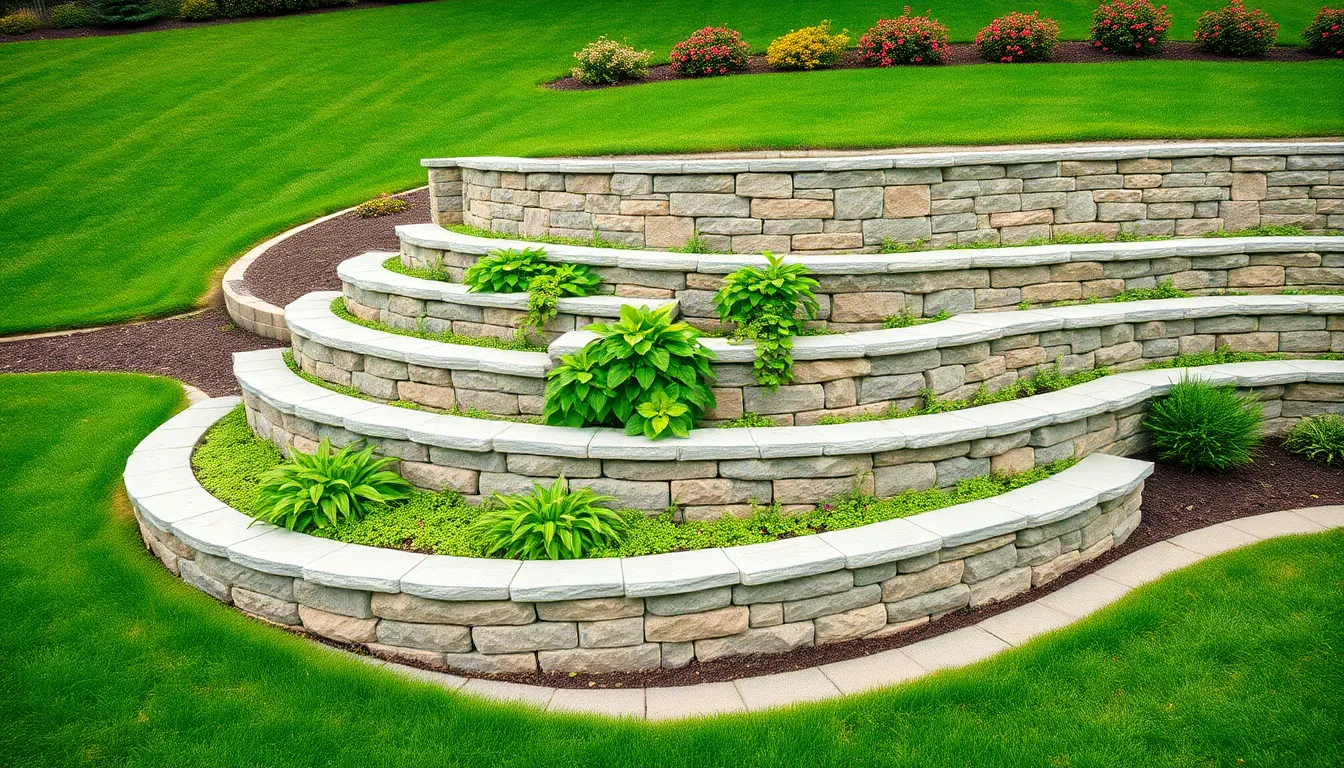
Terraced retaining walls transform challenging sloped areas into functional multi-level outdoor living spaces. These stepped structures break steep inclines into manageable flat tiers while reducing the structural demands of single high walls.
Multi-Level Stone Terracing
Natural stone terracing creates stunning visual layers that maximize both functionality and aesthetic appeal in sloped patio areas. Stacked fieldstone, limestone blocks, or granite slabs form successive retaining walls at different elevations, with each terrace serving as a distinct garden bed or seating area. Stone materials provide the structural integrity needed for multi-level designs while offering timeless beauty that complements both rustic and contemporary outdoor spaces.
Building these terraced stone walls requires careful planning of each tier’s height and spacing to ensure proper load distribution. We recommend keeping individual terrace walls between 3-4 feet high to maintain structural stability without requiring engineering permits in most areas. Each stone terrace can accommodate colorful shrubs, flowering plants, or herb gardens that cascade naturally between levels.
Installation involves creating stepped foundations that follow the slope’s contour while maintaining level surfaces for each terrace. Proper base preparation with compacted gravel ensures long-term stability, while selecting stones with consistent thickness helps achieve uniform wall heights across multiple tiers.
Planted Terraces with Built-In Drainage
Incorporating drainage systems into planted terraces protects retaining wall structures from water damage while supporting healthy plant growth. Built-in drainage prevents water accumulation behind walls that can cause structural failure, frost heaving, or plant root problems. French drains, weep holes, or gravel backfill systems channel water away from retaining structures effectively.
Gravel layers behind each terrace wall create efficient water flow paths while supporting proper soil drainage for planted areas. We recommend installing perforated drain pipes at the base of each terrace to collect and redirect water to designated drainage areas. This drainage infrastructure maintains wall integrity while creating optimal growing conditions for terraced plantings.
Plant selection for terraced designs should consider drainage capabilities and root systems that won’t compromise wall stability. Deep-rooted plants like ornamental grasses work well in upper terraces, while shallow-rooted groundcovers suit lower levels where drainage concentrates. Drip irrigation systems can be integrated into terrace designs to provide consistent watering without oversaturating the soil behind retaining walls.
Curved Terraced Designs for Flowing Landscapes
Curved retaining walls introduce organic flowing lines that blend naturally with industry contours and garden pathways. These curved terraced designs create visual interest through their serpentine shapes while maintaining the functional benefits of traditional straight terracing. Segmental concrete blocks or shaped stones adapt easily to curved configurations, allowing creative freedom in terrace layout.
Constructing curved terraces requires flexible materials that can follow industry bends without compromising structural integrity. Interlocking blocks with curved faces work particularly well for these applications, as they maintain proper connections while achieving smooth radius turns. The curved approach works especially effectively in large patio areas where seamless transitions between terraced levels enhance spatial flow.
Design flexibility increases when using curved terracing, as these walls can wrap around existing industry features like mature trees or natural rock outcroppings. We often incorporate built-in seating areas within curved terraces, creating intimate conversation spaces that take advantage of the wall’s flowing geometry. Trailing plants like creeping phlox or ivy can cascade over curved terrace edges, softening the hardscape transitions and reinforcing the organic design aesthetic.
Strategic placement of curved terraces can direct foot traffic through outdoor spaces while creating distinct zones for different activities. These flowing designs work particularly well when integrated with curved pathways, fire pits, or water features that echo the terrace walls’ organic shapes.
Living Retaining Walls with Integrated Planters
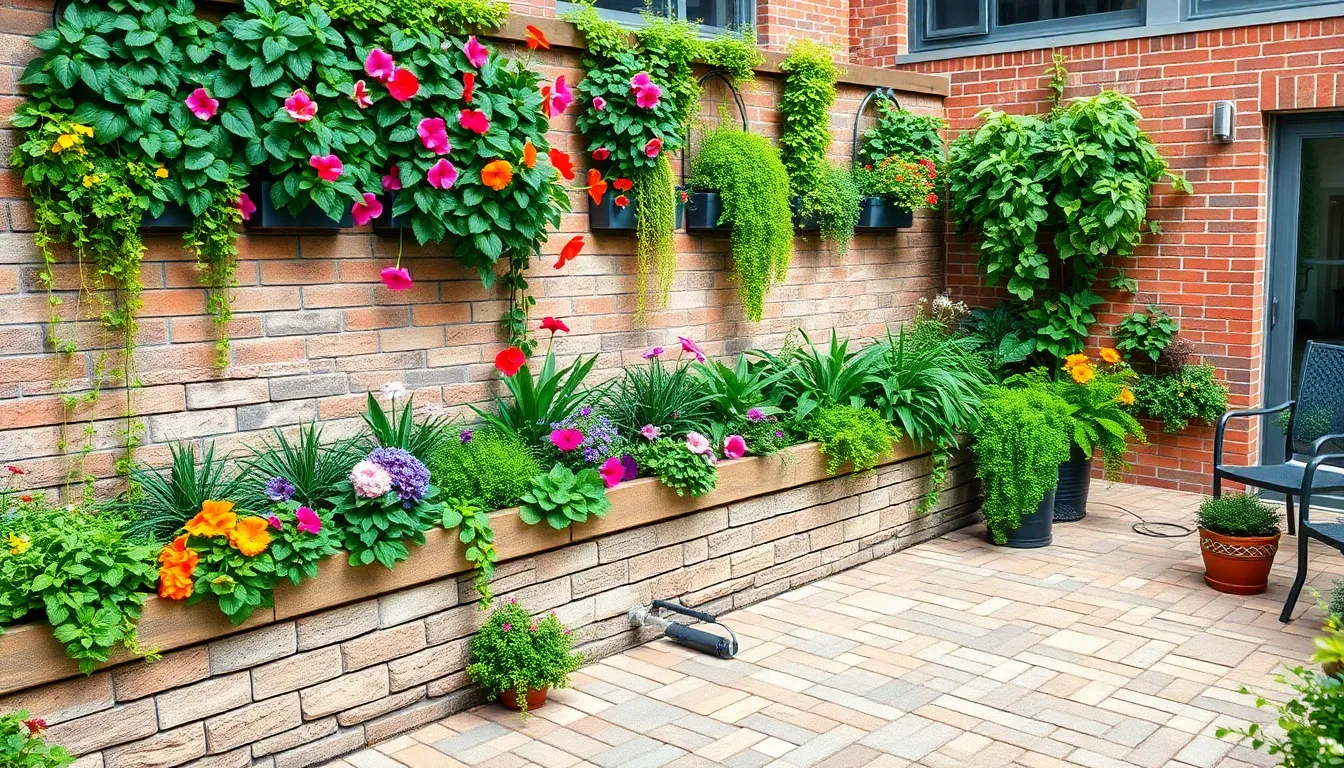
Modern patio design embraces the concept of living retaining walls that merge structural function with natural beauty. We’ll explore how integrated planters transform ordinary retaining walls into vibrant garden features that enhance both stability and visual appeal.
Built-In Planter Boxes for Greenery
Built-in planter boxes seamlessly blend hardscape elements with lush plant life to create stunning patio focal points. Stone, concrete, or brick materials provide sturdy frames that support various plant types while maintaining structural integrity. Multi-tiered retaining walls work exceptionally well for this approach, as each level creates distinct planting beds for shrubs, colorful flowers, or aromatic herbs.
Design flexibility allows us to customize planter dimensions based on exact plant requirements and available space. Trailing vines cascade beautifully over planter edges, softening hard wall lines while adding movement and texture. Seasonal flowers provide year-round color rotation, ensuring the patio maintains visual interest throughout different weather conditions.
Drainage considerations become crucial when incorporating built-in planters, requiring proper water management systems to protect wall stability. We recommend installing gravel beds beneath soil layers to prevent water accumulation and potential structural damage. Strategic plant selection ensures compatibility with local climate conditions while minimizing maintenance requirements.
Vertical Garden Integration
Vertical garden systems maximize greenery potential on limited patio spaces through innovative wall-mounted answers. Modular panels or specialized plant pockets attach directly to retaining wall surfaces, creating living walls covered with diverse plant species. Contemporary designs incorporate hydroponic systems that simplify maintenance while supporting healthy plant growth.
Structural considerations require reinforcement calculations to support additional weight from soil, plants, and water systems. We ensure proper anchoring methods distribute loads evenly across wall surfaces to maintain long-term stability. Privacy screening becomes an added benefit as dense plant coverage creates natural barriers between outdoor spaces.
Plant variety selection ranges from low-maintenance succulents to flowering species that attract beneficial insects and wildlife. Automated irrigation systems can integrate with vertical gardens to maintain consistent moisture levels without manual intervention. Lighting integration highlights plant textures during evening hours, extending visual impact beyond daylight hours.
Succulent Wall Installations
Succulent walls offer drought-resistant answers perfect for water-conscious patio designs and challenging growing conditions. Low water requirements make these installations ideal for regions with limited rainfall or water restrictions. Specialized planting pockets or embedded containers create organized displays while supporting proper root development.
Color variety among succulent species creates living mosaics with purple, blue, green, and silver tones that change seasonally. Texture combinations range from smooth paddle plants to spiky varieties that add dimensional interest to wall surfaces. Growth patterns allow for natural spreading that fills gaps over time, creating fuller coverage without additional planting.
Installation methods include both permanent plantings directly in wall cavities and removable container systems for seasonal changes. We position different succulent sizes strategically to create visual balance while ensuring adequate growing space for mature plants. Winter protection may require covering systems in colder climates to prevent freeze damage and maintain year-round appeal.
Conclusion
We’ve explored a diverse range of patio retaining wall answers that can transform any outdoor space from challenging terrain into an inviting retreat. Whether you’re drawn to the timeless elegance of natural stone or the budget-friendly versatility of concrete blocks each option offers unique benefits for your exact needs and design vision.
The key to success lies in matching your material choice with your industry’s requirements while considering factors like drainage maintenance and long-term durability. From terraced gardens to living walls with integrated planters these structures can serve multiple purposes beyond simple soil retention.
Your patio retaining wall represents an investment in both functionality and beauty. With proper planning and the right materials you’ll create an outdoor space that not only solves practical challenges but also becomes a stunning focal point for years of enjoyment.
Frequently Asked Questions
What are the main benefits of installing patio retaining walls?
Patio retaining walls serve dual purposes: preventing soil erosion and enhancing outdoor aesthetics. They’re perfect for sloped yards, adding dimension to flat spaces, and creating functional features like built-in seating, planters, and multi-level entertainment areas. These walls transform challenging landscapes into inviting outdoor retreats while providing structural support.
Which materials are best for natural stone retaining walls?
Natural stone offers three excellent options: fieldstone for rustic charm with irregular shapes that blend organically with landscapes, limestone blocks for contemporary appeal with clean lines, and granite slabs for sophisticated elegance and durability. Each material provides unique aesthetic benefits while ensuring structural integrity for your outdoor space.
Are concrete block retaining walls a good budget-friendly option?
Yes, concrete block retaining walls are affordable and durable. Interlocking blocks simplify DIY installation, decorative blocks with textured finishes mimic natural stone appearance, and split-face blocks offer a rugged, natural look. These options significantly reduce labor costs while providing excellent structural support and visual appeal.
What timber options work best for retaining walls?
Three timber options excel for retaining walls: pressure-treated lumber for durability and cost-effectiveness, cedar planks for natural weather resistance and attractive aging, and railroad ties for industrial aesthetics and substantial strength. Each option brings natural warmth and character while offering different maintenance requirements and design styles.
How do gabion retaining walls enhance outdoor spaces?
Gabion walls combine industrial elegance with natural materials using wire mesh baskets filled with stones. They provide excellent drainage, texture variations, and can incorporate colored gravel or LED lighting systems. These walls create striking visual focal points while offering functional support for modern outdoor environments.
What are the advantages of terraced retaining walls?
Terraced retaining walls transform sloped areas into functional multi-level spaces. They create stunning visual layers with each terrace serving as distinct garden beds or seating areas. Curved designs introduce organic lines that blend seamlessly with landscapes, enhancing spatial flow and creating zones for various outdoor activities.
Can retaining walls incorporate living elements?
Yes, living retaining walls with integrated planters merge structural function with natural beauty. Built-in planter boxes create vibrant garden features, vertical garden systems maximize greenery in limited spaces, and succulent walls offer drought-resistant, low-maintenance options that create living mosaics while enhancing outdoor aesthetics.
How do brick retaining walls complement outdoor design?
Brick retaining walls offer classic aesthetics with traditional red brick providing timeless appeal, reclaimed brick adding vintage character and eco-friendly benefits, and multi-color patterns creating artistic focal points. They’re versatile, easy to maintain, and harmonize well with existing patio elements for sophisticated outdoor environments.

